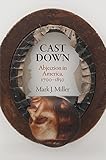Cast Down : Abjection in America, 1700-1850 / Mark J. Miller.
Material type: TextSeries: Early American StudiesPublisher: Philadelphia : University of Pennsylvania Press, [2016]Copyright date: ©2016Description: 1 online resource (240 p.) : 9 illusContent type:
TextSeries: Early American StudiesPublisher: Philadelphia : University of Pennsylvania Press, [2016]Copyright date: ©2016Description: 1 online resource (240 p.) : 9 illusContent type: - 9780812248029
- 9780812292640
- 248.4/7 23
- online - DeGruyter
| Item type | Current library | Call number | URL | Status | Notes | Barcode | |
|---|---|---|---|---|---|---|---|
 eBook
eBook
|
Biblioteca "Angelicum" Pont. Univ. S.Tommaso d'Aquino Nuvola online | online - DeGruyter (Browse shelf(Opens below)) | Online access | Not for loan (Accesso limitato) | Accesso per gli utenti autorizzati / Access for authorized users | (dgr)9780812292640 |
Browsing Biblioteca "Angelicum" Pont. Univ. S.Tommaso d'Aquino shelves, Shelving location: Nuvola online Close shelf browser (Hides shelf browser)

|

|

|

|

|

|

|
||
| online - DeGruyter Embracing Dissent : Political Violence and Party Development in the United States / | online - DeGruyter Showing Like a Queen : Female Authority and Literary Experiment in Spenser, Shakespeare, and Milton / | online - DeGruyter The Widowing of Mrs. Holroyd : A Drama in Three Acts / | online - DeGruyter Cast Down : Abjection in America, 1700-1850 / | online - DeGruyter Turns of Event : Nineteenth-Century American Literary Studies in Motion / | online - DeGruyter The Internet, Social Media, and a Changing China / | online - DeGruyter The Human Rights State : Justice Within and Beyond Sovereign Nations / |
Frontmatter -- Contents -- Introduction. From Roses to Neuroses -- Chapter 1. Conversion, Suffering, and Publicity -- Chapter 2. Indian Abjection in the Public Sphere -- Chapter 3. The Martyrology of White Abolitionists -- Chapter 4. Masochism, Minstrelsy, and Liberal Revolution -- Epilogue. Child Pets, Melville’s Pip, and Oriental Blackness -- Notes -- Index -- Acknowledgments
restricted access online access with authorization star
http://purl.org/coar/access_right/c_16ec
Derived from the Latin abiectus, literally meaning "thrown or cast down," "abjection" names the condition of being servile, wretched, or contemptible. In Western religious tradition, to be abject is to submit to bodily suffering or psychological mortification for the good of the soul. In Cast Down: Abjection in America, 1700-1850, Mark J. Miller argues that transatlantic Protestant discourses of abjection engaged with, and furthered the development of, concepts of race and sexuality in the creation of public subjects and public spheres.Miller traces the connection between sentiment, suffering, and publication and the role it played in the movement away from church-based social reform and toward nonsectarian radical rhetoric in the public sphere. He focuses on two periods of rapid transformation: first, the 1730s and 1740s, when new models of publication and transportation enabled transatlantic Protestant religious populism, and, second, the 1830s and 1840s, when liberal reform movements emerged from nonsectarian religious organizations. Analyzing eighteenth- and nineteenth-century conversion narratives, personal narratives, sectarian magazines, poems, and novels, Miller shows how church and social reformers used sensational accounts of abjection in their attempts to make the public sphere sacred as a vehicle for political change, especially the abolition of slavery.
Mode of access: Internet via World Wide Web.
In English.
Description based on online resource; title from PDF title page (publisher's Web site, viewed 25. Jun 2024)


